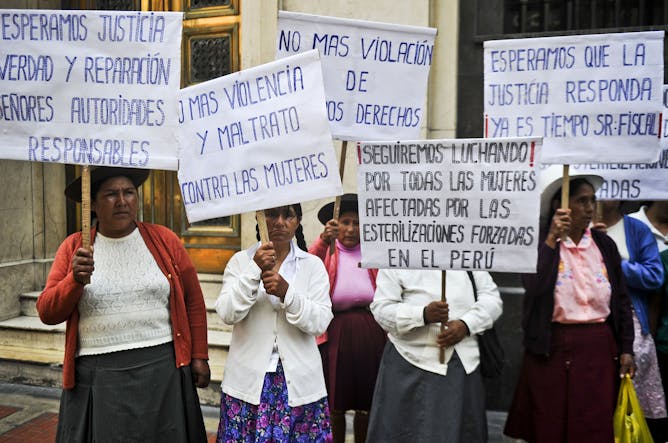|
After the politics desk was finally freed from the yoke of nonstop U.S. election coverage, international editor Catesby Holmes was able to get back to her global network of scholars and start commissioning stories on subjects ranging from anti-vaxxers in 1904 Brazil to police protests in Nigeria, and to the current incidence of election violence worldwide.
This week, she brought readers an edifying – and horrifying – story about forced sterilization of Indigenous women in Peru, by scholar Ñusta Carranza Ko. The authoritarian Fujimori regime’s sterilization of almost 275,000 people – euphemistically called a “family planning” measure – took place between 1996 and 2001. Carranza Ko writes that “the crime of forced sterilization has been underplayed in Peru’s post-Fujimori reckoning with the
past.” The main target of the government’s effort: Indigenous women of Quechua descent, whose high birth rate the government wanted to diminish.
Now, writes Carranza Ko, “in public hearings that began earlier this year, thousands of these women are demanding justice.”
We also had stories this week on the history of the filibuster in the U.S. Senate, how the news industry’s push for engagement with the public can set their journalists up for abuse (especially if those
journalists are women) and an examination by journalism scholar Joshua Braun of “whether it’s feasible – or wise – for cable companies to play moderator to the channels they carry.”
|

Victims of forced sterilizations protest in Lima, Peru, in 2014. Public hearings to uncover this dark chapter of the Fujimori dictatorship began in January.
Erneseto Benavides/AFP via Getty Images
Ñusta Carranza Ko, University of Baltimore
Forced sterilization of Indigenous women was a covert part of 'family planning' under Fujimori. Over 200,000 Peruvians underwent tubal ligations between 1996 and 2001 – many without their consent.
|

A pro-LGBTQ poster at Bosphorus University in Turkey with the image of the mythical creature Şahmeran.
Via Twitter
Christiane Gruber, University of Michigan
Student protesters in Turkey recently used this mythical figure to express their queer identity. An art historian explains the significance.
|

U.S. Sen. Chris Murphy, a Connecticut Democrat, launches a filibuster in 2016.
Senate Television via AP
Joshua Holzer, Westminster College
The US system was designed with more checks and balances than many other successful democracies – the filibuster's main function is to give undue power to a vocal minority.
|
|
|
-
Jacob L. Nelson, Arizona State University
News organizations are in low repute. To enhance their credibility, they've encouraged interaction between their journalists and audience members. Is that the best way to build the public's trust?
|
|
|
|
-
Joshua Braun, University of Massachusetts Amherst
Cable providers like Comcast carry Fox News and other channels that feed conspiracy theories and lies into Americans' homes.
|
|
|
|
-
Richard Amesbury, Arizona State University
Donald Trump didn't make a triumphant return on Jan. 20 and is unlikely to on March 4. How a 19th-century religion dealt with a similar disappointment may give clues on how QAnon supporters may react.
|
|